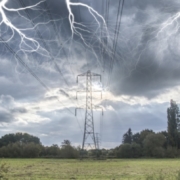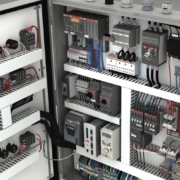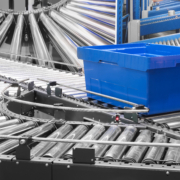3 levels of device monitoring
John Belshe & Kevin Jordan
Product Marketing Managers
ABB Electrification Products Division
More and more panels are incorporating smarter breakers with sensors that can provide alerts and take action when they detect an issue. Panel builders can choose from 3 levels of device monitoring, taking a good/better/best approach to providing their customers with these benefits.
Today, we know more than ever about what’s happening in our homes. Smart doorbells let us see who’s there even when we’re in another room … or not at home! When food staples are running low, they can automatically be added to the shopping list. We can get a text or email warning us that our plumbing sprung a leak. All of this information is made available courtesy of new, lower-cost sensors. And much of this information is available to us regardless of where we are because the sensors are connected to a network.
The sensors mentioned above mainly benefit residential users, but there is also an array of industrial applications where circuit-breaker-mounted sensors are providing facility managers with new and valuable data regarding the status and health of critical production and process assets. Panel builders are increasingly taking advantage of these sensors to provide their customers with panels that deliver expanded functionality and increased sophistication.
Sensors are available that provide not just an open/ close status indication, but a rich variety of data including voltage levels, phase issues, temperature, and power consumption.
Some customers may be interested in high-tech solutions providing detailed, real-time feedback. Others may need only the simplest sort of status feedback. Technology exists to meet both of those extremes and a range of needs in between. One way to think about adding intelligence to panels is the classic good/better/best approach.
Good: Basic alarms and alerts
For almost as long as there have been machine tools and process operations, there have been warning lights and alarms to summon someone when there was a problem. Whether located on the panel or a nearby stack light, this feedback alerted the local operator that action is required on their part.
Today’s enhanced sensors elevate the capabilities of these basic warnings while still keeping things simple. Even the smallest facilities have critical assets like key pumps and motors that require close monitoring. A sensored breaker provides a simple plug-and-play solution that can help prevent unexpected breakdowns and downtime.
An increase in current on a critical pump, for example, can provide an indication that it’s working harder than usual. That could mean something as simple as the need to change the filter, or it indicate the need to check for other, more serious issues.
An alert is valuable, but sometimes action, like shutting down the asset or process, is appropriate. This is particularly true in remote assets where a warning light or siren could go unnoticed. Sensored breakers typically have internal contacts that can take potentially asset-life-saving action.
One the big benefits of using a breaker-based sensor solution rather than the traditional external relay approach is that the capability is embedded in the breaker. There’s no need for the additional relay and the related wiring, all of which adds to the complexity, and therefore reduces the reliability, of the warning circuit.
Better: Plant-wide awareness of asset health
The data available from the breaker doesn’t change much between the good and the better solutions. What does change is what happens with that data. Sensored breakers typically also have built-in communication capabilities. That makes it possible to put the breaker on a local network so operators can receive alerts and alarms at remote locations.
Capitalizing on this capability could hardly be simpler because you can typically rely on whatever network you already have in place. These breakers speak many languages — Modbus, RTU/TCP, PROFINET, PROFIBUS, Ethernet IP, etc. — so there’s usually no need to add communication or network devices. That makes this an ultra-low-cost way to keep a remote eye on assets and processes.
These remote-monitoring capabilities put users on the path toward a predictive maintenance process. With the ability to monitor various health parameters of the asset or process served by the breaker, it’s possible to begin identifying worrisome trends before the escalate into serious problems. It also reduces the need to send techs to remote sites to check up on things. A warning that there’s a voltage difference between phases in a distant pump house can trigger a visit by techs to check things out. This eliminates tech travel time while avoiding power- quality problems that could greatly shorten asset life.
Even if the customer doesn’t see a current need for this kind of feedback, incorporating sensored breakers today makes the panel future-ready for system enhancements and new capabilities.
Best: Cloud-enabled asset monitoring
The highest level of capability is realized by connecting the breaker and/or panel to the cloud. This typically requires some additional systems and cost, but greatly amplifies the value of the breaker data. Now operations and maintenance people can be kept informed of any potential issues whether they are in the same building or on the other side of the world.
This approach eliminates the need for a local server or facility infrastructure. All that’s required is a connection to the network. As with the “better” approach described above, it’s possible to not only monitor the breaker but also control it remotely. If operators identify a potential problem, they can take action via the breaker to protect the asset or process.
Smarter and smarter
Adding intelligence to panels via smart breakers isn’t new. Forward-looking panel builders have been incorporating this technology for years. But the pace of adoption is accelerating. The relatively low cost and plug-and-play ease of these breakers is encouraging more panel builders to recommend them in their designs. Smart breakers also provide an affordable solution to help meet government mandates to manage and monitor power consumption, like California’s Title 24 Building Energy Efficiency Standards.
Panel builders interested in positioning themselves as being current with latest technology and industry trends should explore the potential for sensored breakers with their customers. Many customers won’t see the value in these kinds of breakers, and in fact they may have no need for the capabilities. Still, it can be beneficial to have the conversation. Even if they don’t buy, the builder will have demonstrated that the customer can count on them to point out technologies that may help improve safety, reliability and competitiveness.
Recommended reading: Take device monitoring to the next level












